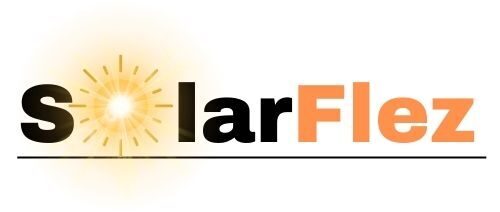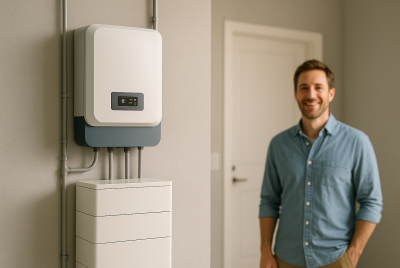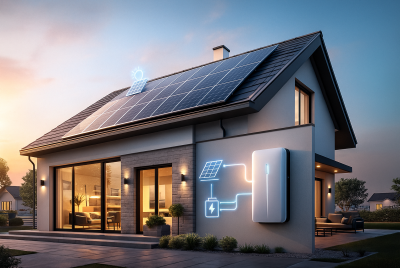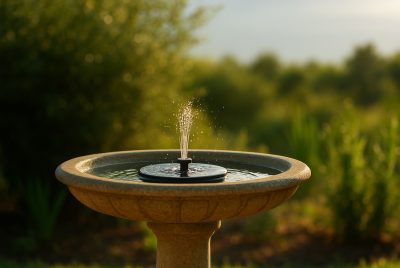Solar Powered Garden Shed: How To Effortlessly Achieve It!
Looking for an easy, eco-friendly way to bring reliable electricity to your backyard workspace? A solar powered garden shed is the answer. This simple upgrade transforms your ordinary shed into a self-sufficient haven for gardening, DIY projects, or just relaxing with a bit of tech at your fingertips. In this guide, you’ll learn exactly how to build a solar powered garden shed, why it’s worth the investment, and which products make the process a breeze—even for beginners.
Why Go Solar in Your Garden Shed?
You already know how useful having power can be if your garden shed serves as more than simply a place to store shovels and pots. Perhaps you’ve imagined how handy it would be to have overhead lighting, power tool charging, or even a fan to cool off during the summer. However, it can be costly and a bit of a bother to extend electrical wiring from your home. This is where a solar-powered garden shed is unique; it provides an easy and affordable solution to produce clean energy at your shed without the hassle of complicated installations or continuous costs.
Solar power isn’t just about being eco-friendly—though that’s certainly a plus. With your own solar setup, you gain energy independence, protection from outages, and even boost your property’s value. Best of all, modern solar kits are more affordable and easier to set up than ever before.
A Solar-Powered Garden Shed: What Is It?
A solar powered garden shed works by using photovoltaic (PV) panels to capture sunlight and convert it into electricity, which is then stored in batteries. That means you can easily run LED lights, charge your power tools, plug in small devices, or even keep a mini fridge cold—all right in your shed. A typical setup includes solar panels (installed on the roof or nearby), a charge controller, batteries, an inverter if you need AC power, and safe wiring to connect everything.
The best thing about it? They are flexible systems. You can scale them up or down to match your shed’s size and your actual power needs. And you don’t need to be a pro electrician—most solar kits are built for DIY installation with just basic tools and a little patience.
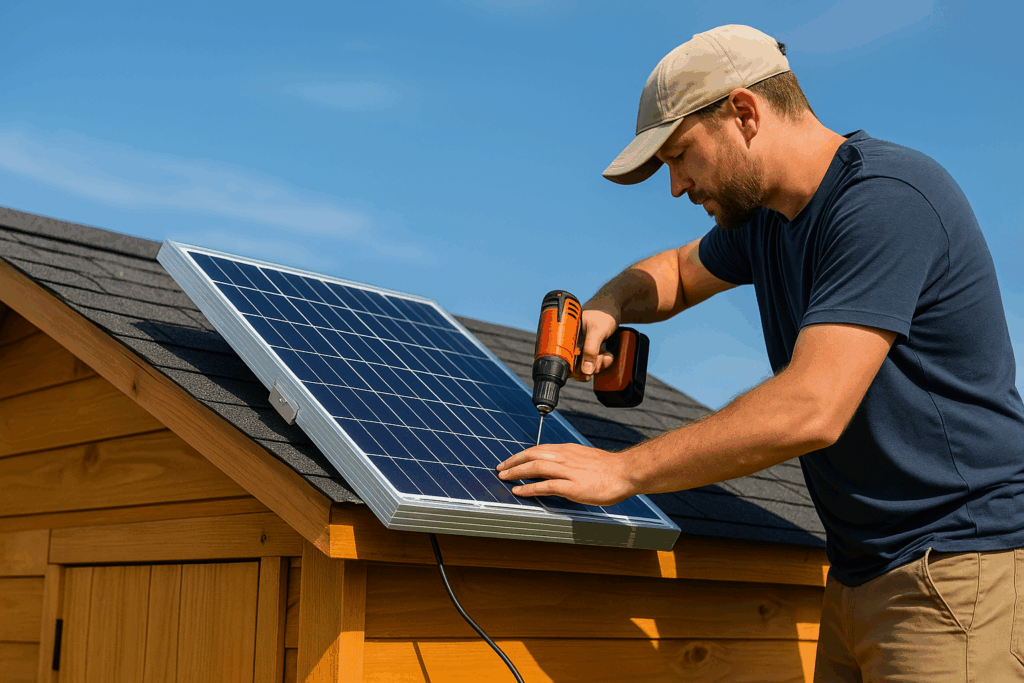
Benefits of Solar Power for Garden Sheds
So why should you choose solar for your shed? Here are a few unbeatable perks:
- Save Money: Once installed, solar energy is completely free. Forget monthly electric bills.
- Eco-Friendly: Reduce your carbon footprint and support sustainable living.
- Reliable Power: Keep your shed lit and powered even during outages or in remote locations.
- DIY-Friendly: Modern solar kits are designed with beginners in mind—no need to hire a pro.
- Low Maintenance: Solar panels and batteries need very little upkeep over time.
How To Plan Your Solar Powered Shed
Calculating Your Energy Needs
Start by making a list of what you want to power in your shed. Add up the wattage for each item and multiply by the hours you’ll use them daily. For example, running two 10-watt LED lights for 5 hours and a 60-watt fan for 2 hours totals 220 watt-hours per day.
Planning your system around your actual use helps you size your solar panels and batteries accurately.
Choosing the Right Solar Panels
Once you know your daily power needs, choose solar panels that provide at least 25% more than that amount, to account for cloudy weather or future upgrades. For most sheds, a 100W to 400W panel setup will do the job. Consider your available roof space and sunlight exposure when selecting panels.
Essential Components You’ll Need
Solar Panels
These are the heart of your system. Choose durable, high-efficiency panels designed for outdoor use. Products like the Tactacam solar panel for outdoor use offer reliable performance and weather resistance, making them a great fit for garden sheds in all climates.
Charge Controller
This device regulates the power coming from your panels before it hits your batteries, preventing overcharging and damage.
Batteries and Storage
Deep-cycle batteries (lithium or AGM) store the solar energy for use when the sun isn’t shining. More battery capacity means more power during cloudy days or evenings.
Inverter
If you want to use standard household tools or appliances, you’ll need an inverter to turn battery DC power into standard AC.
Wiring and Installation Materials
Good wiring, fuses, and mounting hardware keep your system safe and efficient.
Scientific Evidence Supporting Solar Powered Garden Sheds
If you’re wondering whether a solar powered garden shed is more than just a trend, scientific research offers some compelling support. In a real-world case study from Augsburg University, researchers designed and built an off-grid solar work shed to test its practicality. Their findings showed that even an 8’×8′ shed, equipped with solar panels and batteries, could efficiently power tools and lighting for educational and DIY purposes. This study proves that small-scale solar solutions aren’t just viable—they’re highly effective for everyday shed needs.
Additionally, the comprehensive Solar Sheds Explained guide from EnergySage breaks down when and how it makes sense to add solar panels to a shed. The guide highlights the importance of proper panel placement, roof strength, and realistic expectations about energy output. It confirms that, for lighting, charging small tools, and running fans, a solar powered garden shed can be an economical and straightforward project for most homeowners.
In short, both scientific analysis and hands-on experience show that solar powered sheds are more than just a green upgrade—they’re a proven way to bring efficient, off-grid power to your backyard.
Step-by-Step Guide to Setting Up Solar Power in Your Shed
Mounting Panels
Find the sunniest part of your shed’s roof or a nearby spot for ground mounting. Attach your panels securely using the included hardware, and ensure they face true south (in the Northern Hemisphere) at about a 30–40° tilt for best results.
Wiring the System
Connect the panels to your charge controller using weatherproof wiring. Then connect the controller to your batteries. Safety comes first: use fuses and disconnects to protect your system from overloads.
Connecting and Testing
If you need AC power, wire the inverter to your battery bank and connect your outlets or lights. Once everything is wired, test the system during peak sunlight hours. You should see the batteries charging and your devices working as expected.
Maintenance Tips for Longevity
Your solar powered garden shed will run smoothly for years with minimal effort.
- Check your panels regularly for dust, leaves, or snow, and gently clean as needed.
- Check the wiring and battery terminals for loose connections or corrosion.
- Review your charge controller’s readings now and then to make sure everything’s charging properly.
- Test your devices every few months to confirm steady power delivery.

Recommended Products for a Solar Powered Shed
Get started with these highly-rated options available on Amazon:
- Renogy 200 Watt 12 Volt Monocrystalline Solar Panel Starter Kit Includes two high-efficiency panels, charge controller, and wiring—perfect for beginners.
- Jackery Explorer 500 Portable Power Station
Portable backup power—connect solar panels and run small appliances, lights, and more. - ALLPOWERS 100W Flexible Solar Panel
Lightweight and easy to install, especially on small or curved shed roofs. - Renogy Deep Cycle AGM Battery 12 Volt 100Ah
Reliable storage with a long-lasting, maintenance-free battery. - ECO-WORTHY 12V Pure Sine Wave Inverter 600W
Efficient, reliable inverter for running household AC devices in your shed.
Always check compatibility before purchasing and choose products that suit your specific needs and local conditions.
Conclusion: Upgrade Your Garden Shed the Smart Way
A solar powered garden shed isn’t just a modern upgrade—it’s a practical move for anyone wanting a more versatile, self-sufficient space. You’ll save on energy bills, gain independence from the grid, and enjoy peace of mind knowing your shed will always be powered up, no matter what. With some planning and a weekend’s work, you can have clean, free energy lighting up your backyard retreat. Ready to give your shed the solar boost it deserves? Start your project today and enjoy the benefits for years to come.
FAQs
Q1: How much does it cost to install solar in a garden shed?
Basic systems with panels, batteries, and wiring can start around $300–$800, but costs rise with bigger setups or higher-end components.
Q2: Can solar panels power heavy tools or large appliances?
You can easily run lights and small devices. For larger equipment, size your system accordingly and check your total wattage before buying.
Q3: Do I need permits for a solar powered garden shed?
Small, off-grid systems often don’t need permits, but local rules vary. Before starting, make sure to verify with your county or city.
Q4: What is the average lifespan of batteries and solar panels?
Batteries normally last 3–10 years with proper care, but solar panels can last 20–25 years.
Q5: Can I later upgrade my solar system?
Yes! Most setups are modular, so you can add more panels or batteries as your power needs grow.
